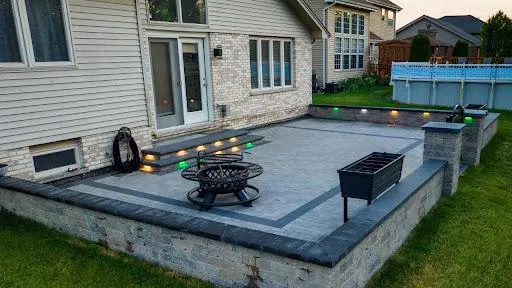Blogs

Can You Put Pavers Over Concrete?
Yes, pavers can be installed over concrete using mortar or adhesive to secure them. However, it's crucial to make sure the existing concrete is clean, level, and in good condition to ensure a stable and durable result.
Looking to upgrade your outdoor space without the hassle of tearing out old concrete? You might be wondering if you can put pavers over concrete to enhance your patio, driveway, or walkway. The answer is yes, you can! This method not only saves time and effort but also adds a fresh, appealing look to your existing surfaces. However, before diving into this project, there are a few important factors to consider to ensure a successful installation.
At Landscaping Experts Inc, we specialize in creating beautiful outdoor living spaces and can guide you through the process to achieve a stunning transformation.
Key Takeaways
Concrete Condition: Ensure the existing concrete is in good condition. Minor cracks can be managed, but major damage may require removal.
Height Considerations: Adding pavers will increase the height of the surface, which could affect doorways and drainage.
Drainage: Proper drainage is crucial. Drill small holes or use permeable pavers to manage water runoff effectively.
Installation Process: Clean the surface, apply a sand layer, place pavers, and use polymeric sand to lock them in place.
Pros and Cons: While this method is cost-effective and visually appealing, be aware of potential height issues and the possibility of cracks affecting the pavers.
Installing Pavers Over Concrete: Key Considerations, Process, and Pros & Cons
Concrete Condition
Before installing pavers over concrete, it's essential to assess the condition of the existing concrete. The concrete surface must be structurally sound to support the pavers. Minor cracks can often be addressed with fillers or sealants, but if the concrete has significant damage or structural issues, such as major cracks, unevenness, or settling, it may be more practical to remove and replace it. Ensuring that the concrete is in good condition helps prevent future problems with the pavers and ensures a smoother installation process.
Minor Cracks: Can be managed with fillers.
Major Damage: May require removal of the old concrete.
Structural Issues: Check for unevenness or settling.
Height Considerations
Installing pavers over concrete will increase the height of the surface, which can have implications for the overall accessibility and functionality of the area. This height increase can affect door thresholds, creating potential tripping hazards or requiring adjustments to door frames and entryways. Additionally, the new height can interfere with existing drainage systems, potentially causing water runoff issues. Planning for these height changes is crucial to avoid problems and ensure a seamless transition between different surfaces.
Door Thresholds: May need adjustments.
Tripping Hazards: Increased height could be problematic.
Drainage Systems: Ensure proper management to prevent issues.
Drainage
Effective drainage is crucial when installing pavers over concrete because the concrete surface itself does not allow water to permeate. To manage water runoff and prevent water accumulation beneath the pavers, it's necessary to address drainage properly. This may involve drilling small holes in the concrete to facilitate water flow or opting for permeable pavers that allow water to pass through. Proper drainage helps to avoid water-related issues and extends the lifespan of the paver installation.
Drilling Holes: Helps with water flow.
Permeable Pavers: Allow water to pass through.
Water Accumulation: Prevents issues beneath pavers.
Installation Process
The process of installing pavers over concrete involves several key steps to ensure a successful outcome. Begin by thoroughly cleaning the concrete surface to remove dirt and debris, often using a pressure washer. Next, apply a thin layer of sand over the concrete to level the surface and aid in drainage. Place the pavers on the sand layer, securing them with thicker border pavers and filling the joints with polymeric sand to lock them in place. Following these steps ensures that the pavers are properly installed and stable.
Surface Cleaning: Use a pressure washer.
Sand Layer: Apply a thin layer for leveling.
Paver Placement: Secure with border pavers.
Polymeric Sand: Lock pavers in place.
Pros and Cons of Putting Pavers Over Concrete
Installing pavers over concrete offers several advantages, such as cost-effectiveness and aesthetic improvement. This method can save time and labor compared to removing and replacing concrete, and it allows for creative design options with various paver styles and colors. However, there are potential downsides, including the increase in surface height, which may require adjustments, and the possibility that underlying cracks in the concrete could eventually affect the pavers.
Pros:
Cost-Effective: Saves time and labor.
Aesthetic Improvement: Enhances curb appeal.
Cons:
Height Increase: May need adjustments.
Cracking Issues: Potential
Benefits of Using Pavers for Outdoor Spaces
Pavers offer multiple advantages for outdoor areas, combining durability, aesthetics, and functionality. They are less prone to cracking compared to concrete and can be easily replaced if damaged. Pavers enhance curb appeal, improve water drainage, and are versatile for various landscaping applications.
Durability: Less likely to crack; can be replaced if damaged.
Aesthetic Appeal: Available in various styles and colors.
Versatility: Suitable for driveways, patios, walkways, etc.
Water Drainage: Reduces puddles and erosion.
How to Prepare Your Concrete Surface for Paver Installation
Proper preparation of the concrete surface is essential for a successful paver installation. Start by cleaning the surface thoroughly with a pressure washer. Check for and repair any cracks or damage before applying a primer for better adhesion. Ensure the surface is level for optimal paver placement.
Clean Surface: Use a pressure washer to remove debris.
Repair Cracks: Fill minor cracks or address major damage.
Apply Primer: Improves adhesion between concrete and pavers.
Check Level: Ensure surface is even and obstacle-free.
Choosing the Right Pavers for Your Project
Selecting the appropriate pavers is crucial for achieving the desired look and functionality of your outdoor space. Pavers come in different materials like concrete, brick, and natural stone, each offering unique benefits. Consider factors such as material, color, texture, and durability for the best results.
Material Choices: Concrete, brick, or natural stone.
Aesthetic Options: Various colors and textures available.
Durability: Choose thicker pavers for high-traffic areas.
Maintenance: Consider ease of upkeep for chosen material.
Maintenance Tips for Paver Surfaces
Maintaining paver surfaces is straightforward but vital for their longevity. Regular cleaning with mild detergent and a pressure washer helps remove dirt and stains. Inspect periodically for any shifting or damage, and replace or repair damaged pavers as needed. Applying a sealer can protect against staining and weathering.
Regular Cleaning: Use mild detergent and a pressure washer.
Inspect Periodically: Look for shifting or damage.
Replace Damaged Pavers: Address issues promptly.
Apply Sealer: Protects against stains and weathering.
DIY vs. Professional Paver Installation
Choosing between DIY and professional paver installation depends on your skills and budget. DIY can be cost-effective but requires significant time and effort. Professionals, like those at Landscaping Experts Inc, offer expertise and specialized tools, ensuring a high-quality finish and fewer long-term issues.
DIY: Cost-effective but time-consuming and requires skill.
Professional Installation: Offers expertise and quality finish.
Specialized Tools: Professionals use advanced tools for better results.
Long-Term Quality: Professional work often results in fewer issues.
Frequently Asked Questions About Pavers
1. Is it a good idea to put pavers over concrete?
Yes, installing pavers over concrete can be beneficial if the existing concrete is in good condition. This method enhances the appearance of old concrete surfaces without the need for removal. However, it's important to ensure the concrete is structurally sound and to consider potential issues with increased surface height affecting doorways and drainage.
2. Can you cover a concrete slab with pavers?
Yes, you can cover a concrete slab with pavers. This process involves cleaning the concrete, repairing any damage, and laying a sand or mortar layer to level the surface before placing the pavers. This approach is effective for improving the aesthetics of existing concrete surfaces.
3. How to stick pavers to concrete?
To stick pavers to concrete, first clean the concrete surface thoroughly. Apply a construction adhesive or mortar designed for outdoor use, then place the pavers onto the adhesive and press them down firmly. After the adhesive sets, fill the joints between the pavers with polymeric sand or grout to secure them in place.
4. Can I lay paving slabs on existing concrete?
Yes, paving slabs can be laid on existing concrete. Ensure the concrete is clean and free of major damage. Apply a bonding primer if necessary, then lay a layer of sand or mortar to level the surface. Place the paving slabs on top and fill the joints to ensure stability and a smooth finish.
5. How thick should pavers be over concrete?
Pavers should typically be 2 to 3 inches thick when installed over concrete. This thickness provides adequate durability and strength for outdoor use. Make sure the combined thickness of the pavers and the underlying sand layer does not cause issues with door thresholds or drainage.
Transform Your Outdoor Space with Pavers Over Concrete
Installing pavers over concrete is a fantastic way to enhance your outdoor area without the hassle of removing old concrete. By ensuring the concrete is in good condition and following proper installation procedures, you can achieve a beautiful and durable result. At Landscaping Experts Inc, we have the experience and expertise to guide you through every step of the process, ensuring a seamless and stunning transformation.
Don’t wait – reach out to us now for a free estimate and let us transform your outdoor area into the space of your dreams. Contact us today and take the first step towards a beautiful new patio, driveway, or walkway!

Follow Us
Service Areas
Plainfield
Shorewood
Morris
Lake Forest
Winnetka
Hinsdale
Western Springs
Hinsdale
Service Areas
Wilmette
Northbrook
Montgomery
Deerfield
Saint Charles
Kelinworth
Golf
Campton Hills
Barrington
Hoffman Estates
Copyright © Landscaping Experts Inc. 2025. All Rights Reserved. Privacy Policy. Terms & Conditions. Web Design by Fused Media

